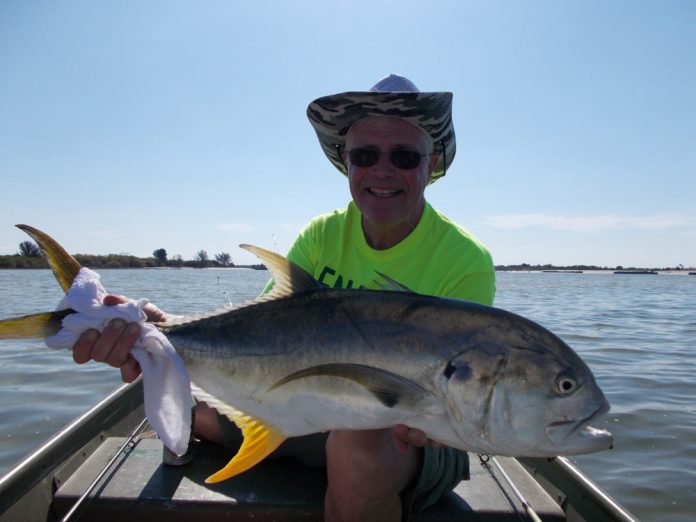One phrase resident and visiting anglers alike enjoy hearing… Mack is back at the Sunshine Skyway Fishing Piers! For the first time in this admittedly young fishing season, limits or near limits of Spanish Mackerel were common over this past week. Mackerel were obviously delighted to find several size classes of scaled sardines, as were visiting anglers looking for lively baits. Sheepshead continued to gather in their normal winter piling locations and also on the artificial reefs. Schools of bluefish and jack crevalle would come and go near the end of each pier as they seemed to be feeding along the main shipping channel. Spotted seatrout are showing reliably in the shallows and are willing to take artificial lures in low light periods.
Spanish mackerel returned with a vengeance this past week, and many visitors took limits of fish ranging from 13″ – 20″. Although the majority of the catch in the mackerel limits I saw this past were in the 13″ – 15″ range, most of the anglers had at least 3 or 4 much larger fish to anchor their catch. A variety of artificial and natural presentations were solid this past week. On the lure side of things, white nylon jigs, silver spoons and Gotcha lures all performed admirably. Visitors were experimenting with retrieves, but it did seem that a slower drop & lift jigging-type outperformed a high-speed burn, perhaps because the water temperature is still not peak for mackerel feeding or due to slightly stained water clarity from winds.
Scaled sardines fished live (either free-lined or under a float) using Size 1/0 long shank hooks were another excellent choice. The smaller 3″ scaled sardines well outperformed the larger & thicker 6″ year classes, but the belly sections of the larger sardines fished in the same manner were also very productive. When your cast net hits a mixture of bait size classes, experiment until you see what the mackerel prefer that day, but always keep a few other baits on ice. Over this week, the cut belly baits of the larger sardines got hit almost as much as the smaller live baits. When you observe the resemblance in both size and appearance in the water, it is easy to see why anglers could ‘mimic’ the smaller offerings with the belly section of a larger sardine. The bite was better early and late in the day, but anglers were able to catch some fish all day long most of this past week.
Anglers looking for great fun with bluefish & jack crevalle found some highly entertaining bites several mornings this past week. At sunrise near the end of the piers, schools of bluefish were busting baits out of the water and beneath these surface-feeding schools were scavenging jacks picking up flesh from the carnage. The bite only lasted a few hours each morning – with fish schools moving in and out of casting range. White buck tail jigs in the 1/2 oz. to 1 oz. class are great for this game because of their versatility. The heavier weight not only gives you greater casting distance, but the size allows you to drop the jig into the depths to see if trailing blues or jacks can be tempted – even as the visible boiling surface feeders pass. Bluefish are a popular culinary choice for cheesy fish bakes and chowders, while smaller jacks can be used in many forms of fish cookery. Both of these species are better on the table if bled for a short time in a bucket of saltwater before being placed on ice in a cooler.
Some beautiful spotted seatrout continue to be taken along the approach sections to each fishing pier. Schools will move in and out with the tide and continually adjust to the point of sunlight, but these fish will not stray too far from the rock retaining walls that serve as heat radiators for the surrounding waters. Anglers can spot trout hugging the bottom and hugging stray rocks. Slow bouncing a 3/8 oz. jig with a swim, jerk or curly tail style soft plastic bait out-performed live bait this past week. Of course spotted seatrout will almost always hit a nice free-lined live shrimp if they are feeding, but sometimes in the winter game you have to locate the fish most willing to feed amongst the group. In this scenario, artificial lures will almost always out-perform natural options only because it is much easier and faster to make multiple presentations seeking the few select fish that will strike.
- The Skyway, Paul Bristow - August 24, 2018
- The Skyway, Paul Bristow - August 17, 2018
- The Skyway, Paul Bristow - August 10, 2018










